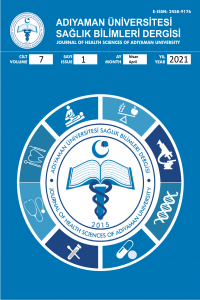Hemşirelik öğrencilerinin vakaya dayalı öğretim tekniğine ilişkin görüşleri: nitel bir çalışma
Hemşirelik, Öğrenci, Vakaya Dayalı Öğrenme
Nursing students' views on the case-based teaching technique: a qualitative study
Nursing, Student, Case-based Learning,
___
- Carl A, Strydom S. e-Portfolio as reflection tool during teaching practice: The interplay between contextual and dispositional variables. South African Journal of Education. 2017;37(1):1-10.
- Dupuis RE, Persky AM. Use of case-based learning in a clinical pharmacokinetics course. Am J Pharm Educ.2008;72(2):1-7.
- Ertmer PA, Newby TJ, Macdougall M. Students’ responses and approaches to case-based instruction: The role of reflective self-regulation. Am. Educ. Res. J. 1996;33(3):719-752.
- Kaptı SB. Vak’aya dayalı öğretim programının etkililiği [Doktora Tezi]. Ankara: Hacettepe Üniversitesi; 2014.
- Majeed F. Effectiveness of case-based teaching of physiology for nursing students. J Taibah Univ Med Sci. 2014;9(4):289-292.
- Mclean SF. Case-based learning and its application in medical and health-care fields: A review of worldwide Literature. J Med Educ Curric Dev. 2016;3:39-49.
- Noohi E, Karimi-Noghondar M, Haghdoost A. Survey of critical thinking and clinical decision making in nursing student of Kerman University. Iran J Nurs Midwifery Res. 2012;17:440-444.
- Smith G. The use and effectiveness of the case study method in management education- a critical review. Management Education and Development. 1987;18(1):51-61. https://doi.org/10.1177/135050768701800107
- Thistlethwaite JE, Davies D, Ekeocha S, Kidd JM, MacDougall C, Matthews P, et al. The effectiveness of case-based learning in health professional education. A BEME systematic review: BEME guide No. 23. Med Teach. 2012;34(6):e421–44. doi: 10.3109/0142159X.2012.680939.
- Yoo M-S, Park J-H. Effect of case-based learning on the development of graduate nurses problem-solving ability. Nurse Educ. Today. 2014;34(1):47-51.
- Mcwilliam PJ. The Case Method of Instruction. Journal of Early Intervention. 1992;16(4):360-373. doi.org/10.1177/105381519201600407
- Elksnin LK. Use of the Case Method of Instruction in Special Education Teacher Preparation Programs: A Preliminary Investigation. Teacher Education and Special Education. 1998;21(2):95-108. https://doi.org/10.1177/088840649802100204
- Merseth KK. Cases, Case Methods, and the Professional Development of Educators. Place of publication not identified: Distributed by ERIC Clearinghouse; 1994.
- Tyler RW. Basic principles of curriculum and instruction. Chicago: University of Chicago. Press, 1949.
- Ordin YS, Bilik Ö, Turhan Damar H, Çelik B. Cerrahi kliniklerdeki hemşirelik öğrencilerinin yansıtma raporlarından elde edilen öğrenme deneyimleri. ENAD. 2018;6(3):106-120. DOI:10.14689/issn.2148-2624.1.6c3s5m
- Kırca Ali-İftar G. Odak grup görüşme tekniği. Özel Eğitim Dergisi. 2004;14(2):7-24.
- Çokluk Ö, Yılmaz K, Oğuz E. Nitel bir görüşme yöntemi: Odak grup görüşmesi. Kuramsal Egitimbilim. 2011;4 (1):95-107.
- Patton MQ, Schwandt TA. Qualitative Research & Evaluation Methods: Integrating Theory and Practice. Thousand Oaks, CA: Sage; 2015.
- Bowling Ann. Research methods in health: investigating health and health services. 4th edition. Maidenhead: McGraw Hill Open University Press; 2014.
- Kitzinger J. The methodology of Focus Groups: the importance of interaction between research participants. Sociology of Health and Illness. 1994;16(1):103-121.
- Krueger RA. Focus groups a practical guide for applied research. 2nd ed. San Diego, CA, Sage Publications; 1994.
- Gibbs A. Focus groups. Social research update 19. department of sociology, university of surrey, surrey, UK; 1997. http://www.soc.surrey.ac.uk/sru/SRU19.html
- Bowe CM, Voss J, Aretz HT. Case method teaching: An effective approach to integrate the basic and clinical sciences in the preclinical medical curriculum. Medical Teacher. 2009;31(9):834-841. DOI: 10.1080/01421590902922904
- Brooke SL. Using the case method to teach online clasess: Promoting socratic dialouge and critical thinking skills. International Journal of Teaching and Learning in Higher Education. 2006;18(2):142-149.
- Williams B. Case based learning--a review of the literature: is there scope for this educational paradigm in prehospital education? Emerg Med J. 2005;22(8):577-581. doi: 10.1136/emj.2004.022707
- Denzin NK, Lincoln YS. Handbook of qualitative Research. 2nd ed. London: Sage Publications; 2000.
- YıldırımA, Şimşek H. Sosyal bilimlerde nitel araştırma yöntemleri. 6.Baskı. Ankara: Seçkin Yayınları; 2013.
- Baysan Arabacı L, Akın Korhan E, Tokem Y, Torun R. Hemşirelik birinci sınıf öğrencilerinin ilk klinik deneyim öncesi-sırası ve sonrası anksiyete ve stres düzeyleri ve etkileyen faktörler. Hacettepe Üniversitesi Hemşirelik Fakültesi Dergisi. 2015:1-16.
- Razzouk R. The effects of case studies on individual learning outcomes, attitudes toward instruction, and team shared mental models in a team-based learning environment in an undergraduate educational psychology course [PhD thesis]. Florida: Florida State University; 2011.
- Ciraj AM, Vinod P, Ramnarayan K. Enhancing active learning in microbiology through case based learning: experiences from an Indian medical school. Indian J. Pathol. Microbiol. 2010; 53: 729– 733.
- Waliany S, Caceres W, Merrell SB, Thadaney S, Johnstone N,Osterberg L. Preclinical curriculum of prospective case-based teaching with faculty- and student-blinded approach. BMC Medical Education. 2019;19(1):1-12. doi.org/10.1186/s12909-019-1453-x
- Peiman S, Mirzazadeh A, Alizadeh M, Mortaz Hejri S, Najafi MT,Tafakhori A, et al. A case based-shared teaching approach in undergraduate medical curriculum: A way for integration in basic and clinical sciences. Acta Med Iran. 2017;55(4):259–64.
- Yayın Aralığı: Yılda 3 Sayı
- Başlangıç: 2015
- Yayıncı: ADIYAMAN ÜNİVERSİTESİ
Mahmut OKSÜZLER, Sema ÖZANDAÇ POLAT, Ayşe Gül KABAKCI
Fazla kilolu ve obez kadınlarda 30 dakika egzersiz kilo kaybı üzerine etkili midir?
Emre BASKAN, Özden BASKAN, Orçin TELLİ ATALAY, Nesrin YAĞCI
Sibel ALTUNIŞIK TOPLU, Yücel DUMAN, Yasemin ERSOY, Emine PARMAKSİZ
Ebru ÖZTÜRK, Zehra CAN, Fatma KARASU, Hasan ÇAM
Yumuşak kontakt lens kullanıcılarında korneal değişikliklerin incelenmesi
Mübeccel BULUT, Abdurrahman BİLEN, Ayşe Sevgi KARADAĞ
Hidrasyonun egzersiz performansı üzerindeki etkisi ve sıvı alım stratejileri
Sağlıklı yetişkinlerde lumbal lordoz ve lumbosakral bölgenin fizyolojik sagital indeks değerleri
Gülru ESEN, Bayram Ufuk ŞAKUL, Selami SERHATLIOĞLU, Tayfun SERVİ
Paratubal dev seröz kistadenom: olgu sunumu
Bir doğum hastanesinde HBsAg tarama testi ve Hepatit B’yi önleme uygulamalarının değerlendirilmesi
